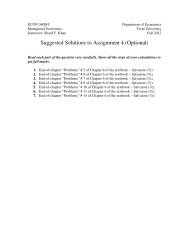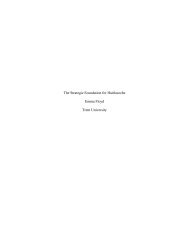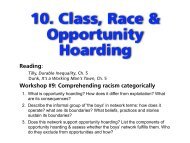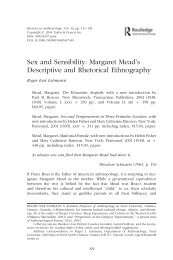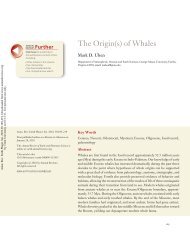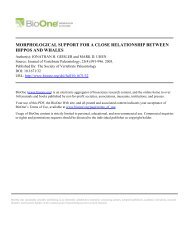REO FORTUNE'S PSYCHOLOGICAL THEORY OF CULTURAL ...
REO FORTUNE'S PSYCHOLOGICAL THEORY OF CULTURAL ...
REO FORTUNE'S PSYCHOLOGICAL THEORY OF CULTURAL ...
You also want an ePaper? Increase the reach of your titles
YUMPU automatically turns print PDFs into web optimized ePapers that Google loves.
Fortune’s Theory of Cultural Ambivalence<br />
Fortune’s Theory in The Mind in Sleep<br />
275<br />
According to Fortune, some of each person’s consciously held beliefs are<br />
shadowed with conflicting beliefs on the subconscious level, accessible in<br />
dreams. Going through life, new attitudes are learned and developed, but<br />
older convictions persist below the surface. For example, the religious convert<br />
may, deep down, remain attached to a former belief system. Intrigued<br />
with the idea that people apparently hold conflicting views simultaneously,<br />
Fortune investigated dreams in which the ego exhibits attitudes that have<br />
been rejected or repressed in waking life.<br />
Fortune disagreed with Rivers’ argument that Freud’s dream theory<br />
was self-fulfilling. Dreams in which a person holds opposite views to those<br />
of waking life, Fortune (1927, ix) argued, showed that “it is easily possible<br />
to exaggerate the influence of waking theory on dreams of the type under<br />
review.” In anthropological terms, The Mind in Sleep is concerned with<br />
conflicting elements of culture in each person’s mind and argues that<br />
dreaming allows for the expression of these incongruous views without<br />
harming social cohesion. In dreams, ideas that have been rejected in the<br />
conscious, social, cosmological, and moral systems remain and find<br />
expression.<br />
This raises questions about how and why rejected beliefs persist, and<br />
why they may be accepted again, at least temporarily, in dreams. Fortune<br />
answered that these ideas retain emotional force, even when they have<br />
been rejected by logical or pragmatic concerns; they resurface in dreams<br />
because of the emotional tenor of dreaming.<br />
Dreaming and waking are characterized by different kinds of thinking.<br />
Waking cognition connects ideas in terms of spatiotemporal relationships<br />
and reason, but “in dreams,” Fortune (1927, 34) wrote, “association by<br />
common affect frequently supersedes association by contiguity and logical<br />
similarity.” In “affective association,” dream images and scenarios are<br />
connected or juxtaposed because they evoke a common feeling. Fortune<br />
considered affective association to be the distinctive characteristic of dream<br />
thought. It dominates dreaming when it is least disturbed by waking attitudes.<br />
As one nears waking, conscious thought patterns invade. When the<br />
conscious attitudes disagree with repressed ones, the intrusion of waking<br />
thought into dreams engages various mechanisms of censorship. These disguises<br />
complicate the affective associative symbolism of dreaming. Fortune<br />
thus disagreed with Rivers’ view that symbolic censorship does not occur<br />
in dreaming. Fortune (1927, 18, 20) considered his own theory closer to<br />
Freud’s in this regard, though he rejected the idea that deeply repressed<br />
attitudes are necessarily or usually sexual.<br />
pacs-32-02-06.indd 275 9/7/2009 2:32:33 PM



